As you explore the breathtaking landscapes and rich history of the Keweenaw Peninsula, it becomes evident that this region was not only shaped by its rugged terrain but also the individuals who have called it home. In celebration of Women’s History Month, we want to share the stories of some of the notable women who have left an indelible mark on Keweenaw history. From pioneer residents and shop owners to labor and woman's rights activists, women have played a significant role in shaping our Keweenaw communities.
Lucena Brockway | Pioneer Resident
Places to visit: Copper Harbor, Brockway Mountain Drive, Michigan Tech Archives
Born in May 1816 in Eden, New York, Lucena Brockway (Harris) and her husband Daniel D. Brockway were pioneer settlers in the Copper Harbor area. The couple moved from downstate Michigan to the Lake Superior region in 1843. After making their way from Sault Ste. Marie aboard the John Jacob Astor, the Brockway's landed in L’Anse, where Daniel had been appointed as the government blacksmith and mechanic. Here, they spent three years assisting members of the Ojibwe community.
The year they moved to L’Anse aligned with the start of the Keweenaw copper mining boom. The 1842 Treaty of La Pointe (known as the Copper Treaty) ceded most Ojibwe land on the northern and western shores of Lake Superior to the U.S. government, allowing for mineral exploration in the region. Initially, tent camps were set up, then later in 1844, Fort Wilkins. At that time, the buildings for the garrison stationed at Fort Wilkins were the only established dwellings in the area. In May 1846, two Ojibwe guides brought Daniel, Lucena, and their three children to Copper Harbor. They built the first substantial house and the first Copper Harbor hotel, which was known as the Brockway House. Here, Lucena spent her days taking care of hotel guests, cooking them meals, and maintaining a clean hotel. After establishing residency in Copper Harbor, the Brockway’s had three more children and became involved with several other businesses as the copper mining boom swept through the region.
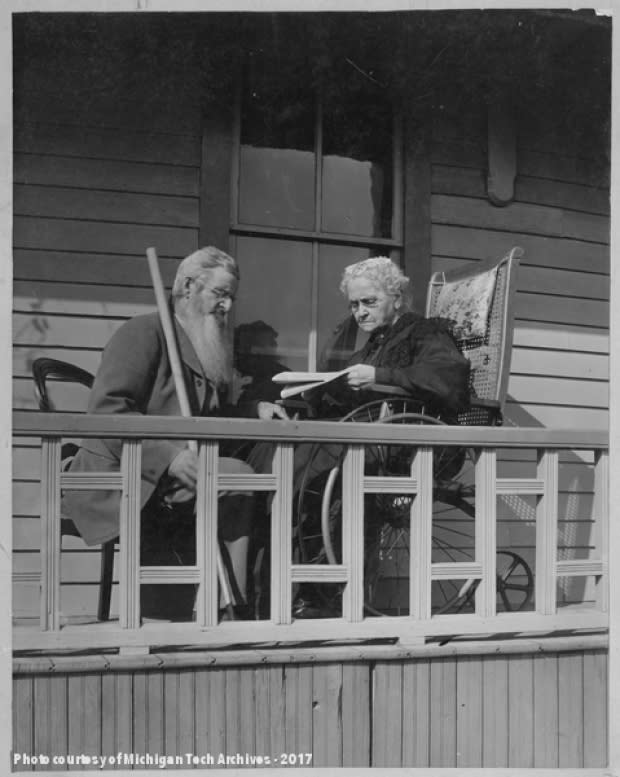
Lucena and Daniel Brockway on their porch later in life. | Michigan Tech Archives
Lucena did a wonderful job of documenting their complete story (and the stories of other pioneer settlers) in diaries that are now part of the Michigan Tech Archives. Through these types of diary entries, it is evident that Lucena Brockway had a pioneering spirit and saw value in documenting this important era of Keweenaw history. The Michigan Tech Archives are open to the public by appointment for those wishing to view this collection.
In 1933, the construction of Brockway Mountain Drive (a must-see 8.8-mile scenic route) was completed as part of the depression-era work programs. It was named after the couple for their role in Copper Harbor development. Eventually Lucena and her husband retired in Lake Linden and were buried together in Calumet’s Lakeview Cemetery.
Want to learn more about the history of Copper Harbor? Check out our Historical Guide to Visiting Copper Harbor.
Information about the Brockway’s was provided by Michigan Tech , the Keweenaw National Historical Park & The Mining Gazette.
Dusala (Bandettini) Barsotti | Early Calumet Shop Owner
Places to visit: Calumet, Bucko’s Party Store
Born in Italy in 1861, Dusala Bandettini immigrated from Italy to Le Havre, France in 1882 where it is believed that she boarded the steamer “France” to join family in Illinois. After arriving in the United States, she married and had three children (Peter, Arthur, and Gemma) with Mr. Ercole Barsotti. By 1900, Dusala’s & Ercole’s son Peter moved to Calumet to live with Michael Bandettini. The rest of the Barsotti family followed after Ercole’s death in 1903.
After arriving in Calumet, they partnered with Angelo Dell’Osso to establish a confectionery and fruit store. Dusala bought out Dell’Osso and became the sole proprietor of the business around 1907. She owned the business until she died. All Dusala’s children worked at the store and eventually Dusala’s daughter Gemma Dianda (and her children) took over the business. At that time, it was known as Dianda’s Party Store, remaining in the family until about 1960. After 1960, there were many different owners, including one of Gemma’s descendants who renamed it Dianda’s.

The early days at Dusala Barsotti's Calumet Store. | Keweenaw National Historical Park.
Dusala’a legacy continues to live on today, as the business that she established so many years ago continues to strive today. The store now belongs to the Buctkovich family and is known as Bucko’s Party Store. Located on the corner of 5th & Elm, Bucko’s offers everything from beer, wine, food, and snacks to DNR/ORV Licenses and Keweenaw Alpaca Gear.
Information provided by Keweenaw National Park Service.
Mary Chase | Pewabic Pottery
Places to visit: Hancock, Michigan Tech Memorial Union Building
Mary Chase Perry was born Hancock in 1867 and is well known for becoming the co-founder of a renowned pottery business known as Pewabic Pottery. Pewabic Pottery still operates today as a501(c)(3) and is a National Historic Landmark in Detroit.
While the organization may be located downstate, its name originated in the Keweenaw, being named after a local copper vein and mine that was located close to Mary’s childhood home. This vein was also worked by Quincy Mine, which visitors can now tour today. Mary and her father would often take walks around these mines, discovering the red clays and minerals that are native to the region. The name Pewabic comes from a Chippewa Indian term meaning “clay with copper color.” Her style of work was simple but used a signature iridescent glaze, that often included copper.
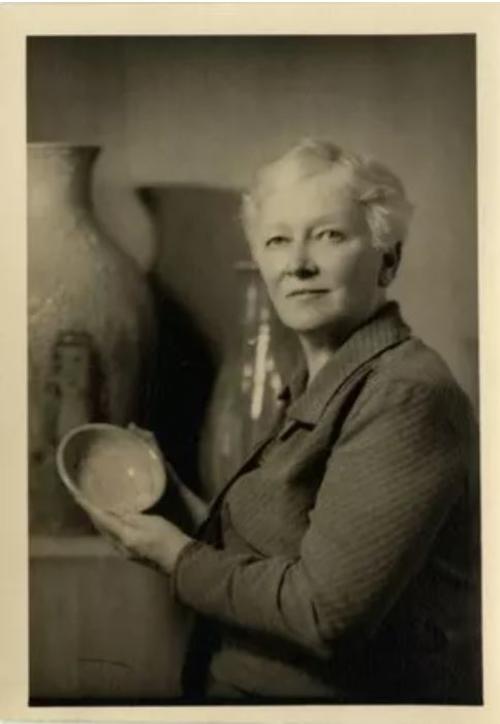
Mary Chase with a bowl she created. | Detroit Public Library via Keweenaw National Historical Park
Pewabic Pottery is well known for its tile work and those stunning iridescent glazes which can be found in Michigan and across the country, adorning homes, schools, churches, and other public areas. Some Pewabic tile work can be found in Houghton High School, a fireplace at the Memorial Union Building at Michigan Tech, and probably other unknown locations throughout the Keweenaw. Pewabic tile can be identified by certain marks and labels. Mary worked hard teaching, creating wonderful masterpieces, and even oversaw pottery operations at Pewabic until her death at the age of 94.
Mary’s childhood home still stands today and is now known as the Celtic House. It was one of the few homes that survived Hancock’s destructive fire of 1869 and is now a National Historic Landmark.
Pewabic Pottery has a wonderful biography of Mary with additional information about her life’s work here. The Mining Journal also featured a great article with more information.
Maggie Walz | Women’s Rights Activist & Entrepreneur
Places to visit: Finnish American Heritage Center, Northwind Books, Finnish Bakeries, Calumet Theatre, Calumet Walking Tour
Maggie Walz was born in Tornio, Finland in 1861, with quite a lengthy name: Margareeta Johanna Konttra Niiranen. She came the United Sates when she was just twenty years old and worked as a domestic servant in the community of Oskar, near Houghton. Maggie had goals as an immigrant in the Copper Country. She worked hard to learn English during night classes, and later mastered her language skills through practice while selling sewing machines, pianos, and organs door-to-door and through her work as a salesclerk.
Her Finnish roots tied her into the Finnish immigrant community, helping it prosper and grow. She introduced many female Finnish immigrants to the area and helped them learn English and find employment in the Copper Country. Her efforts led her to a life working as an independent entrepreneur, providing necessary services to female immigrant groups. In 1894, she organized the Calumet Finnish Women’s Society, which was dedicated to the advancement of woman and later became a national organization. The society published a Women’s Paper that was eventually distributed on a national level. Additionally, Maggie managed a significant Finnish- American newspaper, which was published in Calumet and distributed nationally.
Maggie’s success led her to build a three-story business block on Pine Street in Calumet. It served as the commercial center of Calumet’s Finnish community and was designed by the same architect as the grand Calumet Theatre, which still hosts regular events today.
Maggie’s influence reached far beyond the bounds of the Keweenaw. In 1903, she became a land agent for Drummond Island in the eastern Upper Peninsula and started a Finnish colony there, overseeing it for many years. Later she traveled around the United States establishing branches of Calumet’s Finnish Women’s Society in other locations. Maggie Walz passed away in the Laurium hospital in 1927, but her legacy lives on through the strongly rooted Finnish American heritage in our region.

Maggie Walz with other women in Calumet | Keweenaw National Historical Park
Visitors can learn more about the Copper Country’s Finnish American heritage by visiting the Finnish American Heritage Center (FAHC) in Hancock. The FAHC houses the Finnish American Historical Archive, the world’s largest and oldest collections of Finnish American archive materials. It is also home of the monthly international newspaper, “The Finnish American Reporter,” a spacious community hall that plays host to many cultural events, an art gallery, and museum. Stop by the adjacent Northwind Books for some Finnish and Finnish American literature and gifts.
The region is also home to several authentic Finnish bakeries where you can enjoy the unique Finnish flavors that immigrants brought with them to the Keweenaw. From the custardy Finnish pancake (pannakaku) at Suomi Restaurant to the Cardamom Nisu in at Nisu Bakery & Cafe, it is evident that Finnish American culture lives on in our communities.
Information about Maggie was provided by the Keweenaw National Historical Park. Their article also includes additional information about her life’s work.
Anna Klobuchar Clemenc | Spearheaded the Copper Country Strike of 1913-1914
Places to visit: Calumet, CopperTown Mining Museum (exhibit about Annie), Italian Hall Memorial
Anna Klobuchar was born in 1888 in Calumet, Michigan, and was the daughter of Slovenian immigrants from the Cronmelj District on the border of Croatia. She spent a few childhood years in Slovenia, before her family moved back to the Copper Country where her father worked for Calumet & Hecla Mining Company.
Young Anna eventually grew to a height of 6 foot 2 inches, earning her the nickname “Big Annie.” She graduated from the 8th grade at a school owned by the Calumet & Hecla Mining Company, and at the age of 18, she married her first husband, Joseph Clemenc who worked as a miner for a meager wage of $2.50 a day. Meanwhile, Annie worked at a church taking care of injured miners and did laundry to earn a living. Life at the time was hard and their marriage did not last longer than 1914 due to Joseph’s repeated physical abuse and marital discord.
In 1913, 25-year-old Annie spearheaded a labor movement to improve working conditions for miners and hopefully improve the quality of life for other families like her own. So, in February 1913, Annie founded the Women’s Auxiliary No.15 of the Western Federation of Miners. The Western Federation of Miners was a labor union that formed in 1893 through the merger of several mine unions in the western United States.
The Women’s Auxiliary organized the Copper Country Strike of 1913-1914, which began on July 23, 1913. In a paternalistic system, where mining companies owned miner's homes, schools, churches, and hospitals, the strike sought to earn workers higher wages, shorter workdays, safer working conditions, and union recognition. It was the first unionized strike in the Copper Country, and Big Annie served as a prominent leader of daily strike parades, carrying a large American flag on a ten-foot pole with a crowd of strikers and their families following behind.
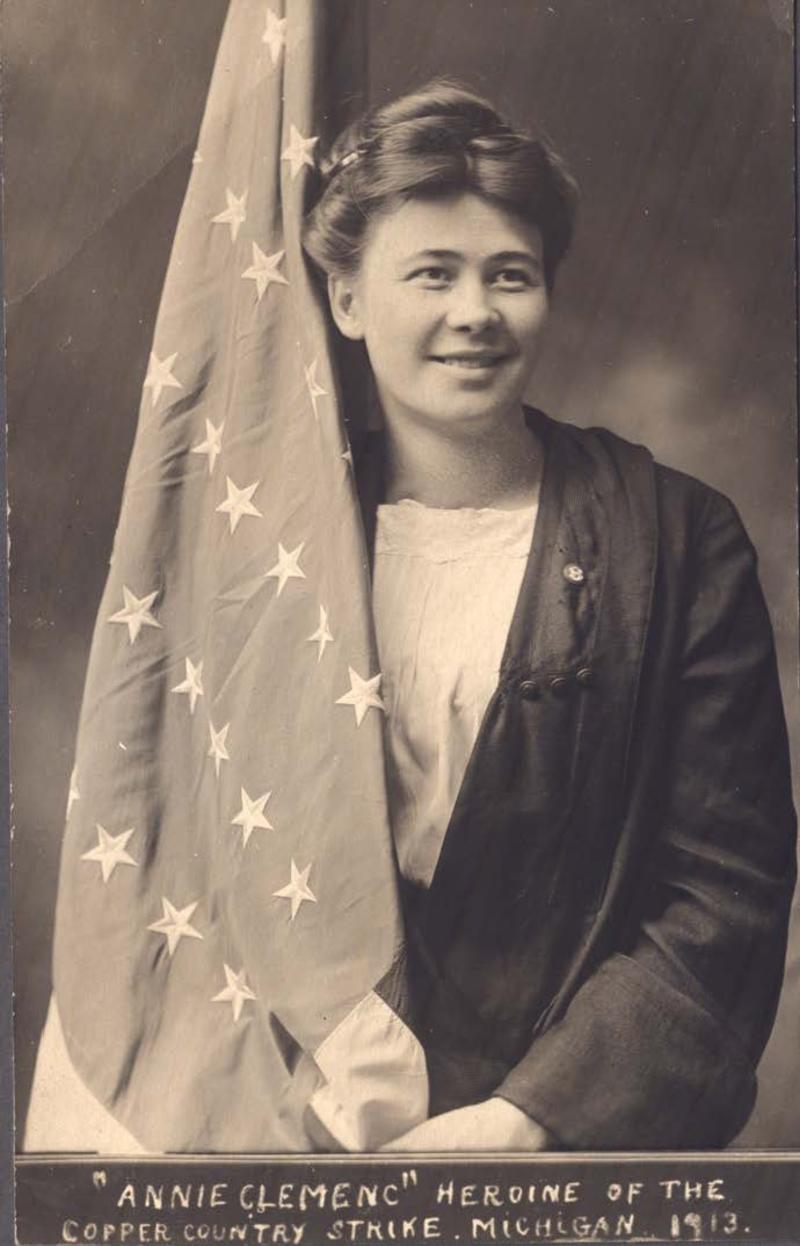
"Big Annie" and her flag. | Keweenaw National Historical Park
Unfortunately, the strike did not proceed without violence. The Calumet & Hecla mining company seemed to have deputies on their side and hired private security agencies to handle affairs. On August 14, 1913, the first fatal incident occurred, after two strikers (John Kalan & John Stimac) walked across company property. The guard on duty notified his supervisor, who sent members of the Waddell- Mahon Detective Agency, a deputy, and the guard to the residence of Kalan. The supervisor requested the men bring Kalan and Stimac back to speak with the supervisor, but Kalan refused and went back inside the boarding house. At this point, the men outside started shooting at the house. Stimac and another man were wounded, and sadly two boarders with no relation to Kalan or Stimac were killed. An impressive crowd of 3,500-5,000 strikers and community members showed up for the funeral procession, which was led by Big Annie. The deaths of these innocent men stirred emotions that increased the intensity of the strike.
Soon after, another incident occurred when 14-year-old striker Margaret Fazekas was shot by a deputy in the back of the head on Labor Day. After an intense fight for her life, Margaret miraculously made a full recovery. A full account of the incident has been provided by Michigan Tech Archives. By this time, the strike had certainly made headlines across the United States, but the most devastating tragedy was yet to come.
In an effort to lift spirts at a time when tensions were high, Annie and the Western Federation of Miner’s Ladies Auxiliary planned a Christmas Party at the Calumet's Italian Hall. The party was held on the second floor on Christmas Eve 1913. The Hall was packed with families, when a false cry of “fire” incited immediate panic. Children and their parents rushed down the steep stairway to exit the building, where sadly a stampede occurred. 73 individuals lost their lives that day, including 59 children. It is believed that the man who yelled “fire” was wearing a badge for the Citizen’s Alliance, an organization that opposed trade unions and the Copper Country Strike. So, again, Big Annie courageously stood forth and led the funeral procession to Lakeview Cemetery. Today, a memorial park with the original stone archway is all that remains of the Italian Hall.
Shortly after the Italian Hall Incident, Charles Moyer, the president of the Western Federation of Miners, was shot in the in the back and forcibly put on a train leaving the region. This was the beginning of the end for the Copper Country Strike of 1913-1914. The Western Federation of Miners was running out of money, and striker’s families were experiencing great hardships through the winter months. Strikers officially voted to end the strike on April 13, 1914.
While the strike was not entirely successful, it is considered a major turning point in Copper Country history and was a part of a much larger labor movement that led to nationwide reforms. Annie has been recognized for her efforts and heroism and is sometimes even referred to as a modern day “Joan of Arc.” Inducted into Labor’s International Hall of Fame and the Michigan Women’s Hall of Fame, Big Annie’s efforts for social justice left a lasting mark on the Keweenaw and beyond.
To honor her legacy, a local advisory committee has been established to raise funds to build a statue of Big Annie in downtown Calumet. Donate to the fund and learn more here. Consider visiting Coppertown Mining Museum to see the special exhibit about Big Annie, or follow along with our Calumet Walking Tour Through Big Annie’s Eyes.
Margaret Holley Chapman | First Woman to Earn a Degree from Michigan Tech
Places to visit: Houghton, Husky Plaza at Michigan Tech
Margaret Holley Chapman was born in Bessemer, Michigan and raised in Lake Linden. She graduated from Calumet High School before receiving a Bachelor of Arts degree from Lawrence College in 1932. At that time she headed back to the Keweenaw and decided to pursue further education at Michigan College of Mining and Technology (now Michigan Tech). She received her Bachelor of Science in General Science in 1933, making her the first female to earn a degree from this school. In 1934, she received her Bachelor of Science in Chemistry and then pursued a master’s program in general science.
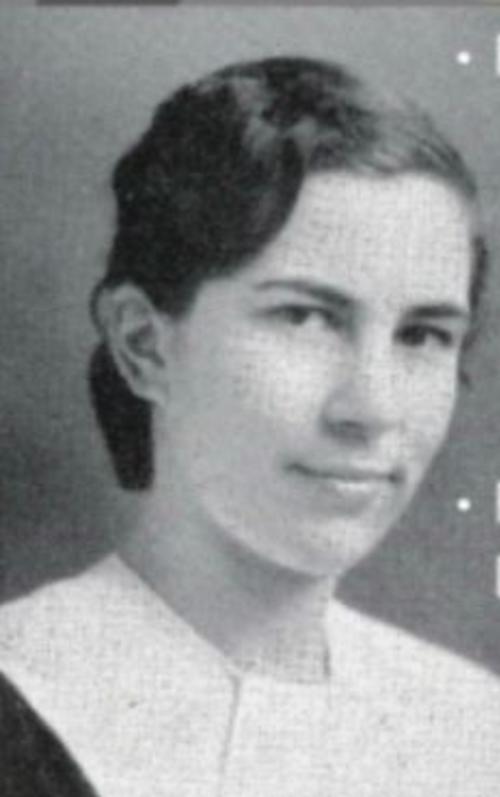
Margaret Chapman, first female graduate of Michigan Tech. | Michigan Tech
Margaret went on to work in the Corrosion Lab as a junior serologist for the Michigan Department of Health, which was located at the college. Later, she became the first female to serve as a fund trustee for the Michigan Tech Fund. Margaret’s success at Michigan Tech paved the way for future generations of female students. Today, Michigan Tech’s female student body population continues to grow, seeing women flourish in every department on campus. See if you can find her name amongst the paver stones near the Husky Statue on Michigan Tech’s campus.
Information about Margaret was provided by records from the Michigan Tech Archives and an article about Women at Michigan Tech that was written in 2019.
Nancy Harkness Love | First Female Pilot in Army Air Forces
Places of interest: Houghton
Houghton-native Nancy Harkness Love was born on February 14, 1914. Her father, Dr. Robert Harkness was a wealthy physician and served as a Public Health Officer for Houghton. His office was near the Portage Lake Lift Bridge in Houghton, and her childhood home was on College Avenue in Houghton.
Nancy’s interest in aviation began at a young age. In 1927, she had the opportunity to witness Charles Lindberg land the Spirit of St. Louis at the Le Bourget Field in Paris after a 33.5-hour non-stop solo flight from New York City to Paris. When Nancy was just sixteen years old, she marveled at a bi-plane flying over as she was out riding a horse. But it wasn’t until Nancy took a flight with a local barnstormer that her spark for aviation was truly lit. At just sixteen years of age, Nancy received pilot training and earned her private pilot’s license. She later received commercial pilot training with her instructor John Miller.

Portrait of Nancy Harkness, the first female pilot in the U.S. Army Air Forces | Hannah Love Robinson via the KNHP
In 1934, Nancy met her future husband, Robert Love, who was an Air Corps Reserve officer. Around that time, she started working in aviation doing everything from airplane sales to heading a project that created navigational aids for pilots. In 1939 WWII broke out in Europe, and she wrote to Lieutenant Colonel Robert Olds to see if she could arrange a female aircraft ferrying squadron. She had a list of candidates prepared yet was initially turned down. Later, her husband was able to speak with the right individuals and the Women’s Auxiliary Ferry Squadron was formed.
At 28 years old, Nancy became the first female pilot of the Army Air Forces and led a squadron of twenty-seven female pilots. Nancy advocated for female pilots, earning them more equal rights as female pilots. Later, she was named the Women’s Airforce Service Pilots Executive in Air Transport Command, ferrying six squadrons and over three hundred women pilots. Nancy was accepted into the National Aviation Hall of Fame and earned an Air Medal for her wartime efforts. Her leadership opened doors for female pilots in the United States, and for that, she will always be remembered.
Information about Nancy Harkness Loves was provided by the Keweenaw National Historical Park’s article and Nancy’s National Aviation Hall of Fame biography page.
Verna Mize | Lake Superior Environmentalist
Places to visit: Lake Superior, Houghton, Verna Mize Rock Park
Born in Houghton, Michigan in April 1913, Verna Grahek Mize graduated from Calumet High School in 1940. After formal education at both private and public schools, she started her federal career working in several different government organizations within the science field. She grew up to become a pioneer in the environmental movement, having a huge impact on the Great Lakes region. On a return trip to the Keweenaw in 1967, made a monumental discovery regarding the clarity of Lake Superior. Her research about the worsening water quality eventually led her to the source: the Reserve Mining Company in Two Harbors, Minnesota had been duping 67,000 tons of waste tailings into Lake Superior each year! After growing up on the pristine shores of Lake Superior, Verna knew that something needed to be done to protect this essential natural resource.
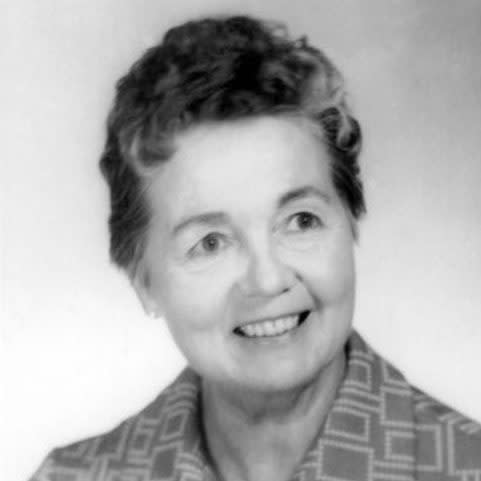
Verna Mize, the "First Lady of Lake Superior" | Michigan Women Forward
Verna Mize led a successful effort to stop the pollution that was happening in Lake Superior. For more than a decade, she rallied citizens and collected signatures for a petition, wrote letters to senators, congressmen, and President Nixon, and followed through with her heart-felt “Save Lake Superior Campaign.” After much effort, the Environmental Protection Agency brought the Reserve Mining Company to trial in 1973, in what was one of the longest and most difficult environmental cases of the time. The lawsuit was settled several years later in 1980, resulting in the end of mine-waste dumping in Lake Superior.
For her extensive work on the environmental front, she has been honored with the title of “First Lady of Lake Superior” by Michigan Governor William G. Milliken, received America Motors Corporation Conservation Award in 1976, and was awarded a United States Department of Commerce medal for her federal service.
In 1981, a small park was erected in the City of Houghton to honor her legacy. The Verna Mize Park includes a beautiful rock display which includes an array of regional specimens and a fantastic piece of float copper. The park is located along the Houghton waterfront on Lakeshore Drive.
Each August the Verna Mize Triathlon in Houghton celebrates and honors her environmental victory.
Information about Verna Mize was collected from Michigan Women Forward and her obituary.
Additional Places of Interest
Keweenaw National Historical Park
Learn more about significant moments in Copper Country history by visiting the Keweenaw National Historical Park (KNHP) Visitor Center. Here, you will find museum exhibits that share immigrant stories, significant moments in mining history, and offer a look into what life was like for mine workers and their families from the peak of the copper mining boom to its demise. KNHP is staffed with knowledgeable rangers that offer tours of downtown Calumet and other places of interest. Be sure to ask about the many different heritage sites pertaining to copper mining history that are scattered throughout the region.
Copper World
Located on historic 5th Street in Calumet, Copper World is a fantastic stop for historians. Not only does this gift shop sell a nice variety of high-quality Keweenaw souvenirs and gifts, but they also have a fantastic selection of books about our local history. Find a biography of Big Annie to read or pick up a cookbook full of immigrant recipes...we are certain you will find something interesting in their book collection.
Carnegie Museum
Visit the Carnegie Museum of the Keweenaw. Located in Houghton, this museum features changing exhibits about the region's cultural and natural history. Interactive exhibits and programming engage historians of all ages. Be sure to grab a map for the Historic Houghton Walking Tour and the Historic Houghton Museum in the Street. As you adventure through downtown Houghton, you will find signs posted on lampposts with a historic view of your current environment. The QR codes allow you to find additional information about Houghton’s historic buildings.
Quincy Mine & Quincy Smelter
Get a first-hand experience of what mine work was truly like in the Keweenaw. Explore the above ground rooms, check out the largest steam hoisting engine in the world, then take a tram down to the entrance of the copper mine. From there you venture through the underground mine on foot, learning about working conditions miners experienced. Then later, head down to the Quincy Smelter on the Hancock Waterfront and learn about the final process that involved refining copper ore to the finished product.
Interested in updates, travel tips and quirky information about the Keweenaw? Just sign up for the Keweenaw Explorer, our monthly e-newsletter. Complete the form…

